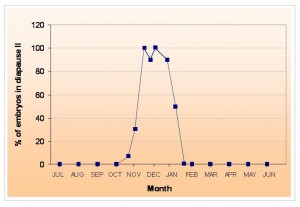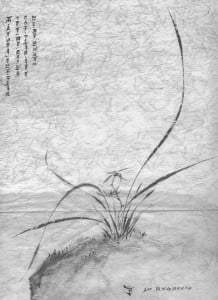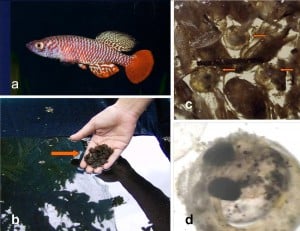This is an odd title and I am stuck with it. Worse, I am compelled to explain why this is so.
Today, I am at a loss what to choose for my next blog entry and trying to find motivation to write about scientific topics of interest to me – malaria, repellents, arsenic poisoning, the oil spill in the Gulf, etc. Not finding the right mood for any of those, I began to read the comments left by readers of my first two blog entries. Then it came to, the inspiration to write, but not on any of those topics. The inspiration is to write about the subject of writing itself.
I asked myself many questions. How come the readers liked those articles? What makes them read them? Is it because I write about things that have personal interest to me? Or, could it be the writing style?
Scientific writing to me, and I started a very long time ago, reminds me of the 1961 movie “The Agony and the Ecstasy.” For those younger folks who regard movies before 1980 as ancient classics, the movie, adapted from Irving Stone’s novel, was about the period when Michelangelo Buonarroti struggled with Pope Julius II on the subject of the painting for the Sistine Chapel at the Vatican. The character of Michelangelo was played by Charlton Heston and that of the Pope by Rex Harrison, two of my favorite actors from the “ancient period.”
Like the painting of the Sistine Chapel, writing my first scientific paper was indeed sheer agony. It really was because the language and style of scientific writing are too precise, too impersonal and too alien. There was none of the flair, the colorful, expressive words that went to writing a history essay, for example. The scientific writing I meant refers to writing for a scientific journal, where your ‘peers” review your research data and render a judgment as to whether you are either wasting their time or have really something unique, worthy of publication in their illustrious journal. It has a language all of its own, propagated through the scientific journals by folks that also seem to be able to write exactly the same way. It seemed to me like these people caught a virus during graduate school that stayed dormant and then get activated only when they start writing for a scientific journal. These are the same folks, who seemed normal and talk normal most times, but suddenly “sings a different tune’, figuratively speaking, when made to write a scientific paper.
It is never the great papers that one writes as the most memorable. It is the ones that gave you the most agony that becomes indelibly imprinted in one’s thoughts. Like in business, the most memorable event is usually not when you made bucket loads of money, but the agony when you lost a big chunk of dough. My first paper, which was on the embryonic development of annual fishes, was one such event. It was based on the work that I did with Jules Markofsky while I was an intern at the Orentreich Foundation in those early days. That was two years of work, mostly repetitive microscopy, looking at fish eggs as they develop. It was worse than watching grass growing in your front lawn. It was the sort of work one gives as punishment (like KP—kitchen police- duty in the army) or for someone to go through during hazing initiation rites in a fraternity.
Then one day, after many very long months, Jules had his Eurekamoment. The numbers began to make sense. For years we were puzzled by the behavior of the developing eggs of the annual fish (You have to read my first blog to make sense of this one). One month they hibernate and in other months they didn’t. But when you line up the data chronologically according to months, then it made sense (see the graph). During summer months, we had no hibernation or diapause in the eggs. But in winter months, there they were. All the animal research facilities were in light-controlled, temperature- controlled environments– so we thought. But we were keeping fishes not in the same animal holding areas, but in our work rooms—with one window not fully covered, open to indirect sunshine. The fish must have sensed the changing photoperiod and that was the reason for the variability in the incidence of diapause. Shorter days in winter meant higher percentage of diapause, despite incubating the eggs at constant 25 oC.
Excited, we wrote the paper, painfully and arduously. But the writing style was just so alien to my nature. Months of revisions go by and finally off it went to the Journal of Experimental Biology, the premier journal at the time and still is today. Then months passed until we received the reviewer’s comments (by snail mail, internet not invented yet). More agony. The most memorable comment was something that goes like this (writing from my memory), “This is the worst paper I had the great misfortune of reviewing. However, the data are so compelling that if the authors can learn how to rewrite it in proper English, the editor should consider publishing it!” That was heartbreaking. My only consolation was that I keep telling myself that the reviewer did not know I was only 17. Again, more agony, more months of rewrite. A year more and it was accepted and one more year of waiting before it finally got its turn on that coveted journal. Two years of work and two years of writing it; then followed by the sheer ecstasy of seeing one’s name in print for the very first time. Thank God there were no online reader comments in those days. Otherwise I would have gone the way of the first captain of HMS Beagle (You will have to read my next blog post to understand that one).
These last two years, I had this habit of re-reading that JEZ paper. The reviewer was right. The paper was atrociously written and still hard to read even now. But, he did recognize that it was a unique explanation for a unique developmental biology of a unique group of fishes. For those masochistic few who desire to read it, please check the first referenced paper below. Don’t blame me if you get a headache.
Ever since then, I get a little better each year. It was an incremental improvement, less agonizing and a little more ecstasy when a paper got printed. Yet, it was never really satisfying.
I always say that scientific writing is like learning tango. No one is born knowing how to dance like that; it is something one has to learn, memorize the moves while trying to avoid your partner’s toes in the process. Then one day, it just happens, you are swinging effortlessly in precise movements in synchrony with the Latin music and you did not step on your partner’s toes, not even once. I never learned tango right, my dance partners did not appreciate their toes getting squashed. But I did try; so at least I can make this analogy with some personal knowledge.
I also say it is like learning Chinese brush painting. I know because I spent half a decade learning the process, so it deserves a little prologue here to show my qualification to make that statement. After my short adventure in the army and while in graduate school, I needed a challenge without having to carry a backpack or rifle all day long. Jules managed to get me a meeting with a prominent Chinese painter, Master Chung-hsiang Chao, who was already 80+ at the time. I was told that he was the only surviving son of the last court painter of Imperial China. The rest of the families were shot when the communists entered Beijing. I never asked him about that episode in his early life. And after much persuasion, he agreed to take me in as a student. I was working full time at the Foundation during the day, taking full time graduate courses on most week nights and my thesis research on weekends. I could only come on Thursday night.
On our first night’s trial lesson at his home/studio on the Upper East Side, I shared his dinner and we painted together. At the end of that session an hour later he said I can come back every Thursday night. I had to ask, reluctantly and agonizingly, how much it will cost for him to teach me. I dreaded the answer because this nice old man sells his painting for $20,000 a piece, me being his only student and, given my position in life then, any amount would have been beyond my means. He smiled and said $7 every Thursday night. I was a bit confused by the offer. He said, “$4 for your share of the cost of dinner that I will make for us and $3 for the ink and paper you use.” And so it was, $7 for each Thursday of those five years until he went back to Taiwan to live the remainder of his years. This experience therefore qualifies me to make this analogy.

The annual incidence of diapause in the annual fish, N. guentheri, maintained at 25 C under ambient photoperiod in New York City.
I say it is like Chinese brush painting (and Japanese paintings too) because like scientific writing, Chinese painting is precision and pure thought. Each brush stroke must be pre-planned; a master painter sees the entire scene of the painting about to be played out on the stretch of rice paper all in advance. Each stroke to create a leaf of a bamboo or a lily plant is planned in his mind, the direction of the leaf, the color of the ink, the amount of ink one needs at the tip, in the middle and at the base of the brush. In one master stroke of the brush, in a single fluid motion, like tango, he creates the bamboo leaf, starting from the dark part of the stem, to the shades of gray of the middle leaf and the dark point of the tip. There is no room for error, unlike in Western painting or pencil sketches, where one may go back to cover up or erase a misguided stroke of the brush or pen. It is agonizing, yet it is also pure ecstasy when one does it perfectly. I must say though that most of those 5 years was just agony, but the short moment’s perfection was ecstasy, making it all worthwhile—just like scientific writing.
But writing this and my previous blog entries are not at all like writing a scientific paper. Here again, something changed in me. Writing for this blog is an entirely different animal. Here, one needs to write about a topic in science with some accuracy, yet make it enjoyable to read for the not so scientifically inclined. It is like a different art form; a different master gene that seems to turn on my other repressed blog science writing genes that had been in hibernation for decades in my brain cells.
This writing style happened just recently. It started when I wrote articles for our company newsletters only last year. But, it did seem to me that this writing style seems so natural, as if I had done it before or perhaps have read something like it before. I had to think hard where I remember such style. This same night, as I was writing this blog entry, it dawned on me. The year was 1978. That was the year when I had my first rare personal meetings with Dr. Norman Orentreich, chairman of the Orentreich Foundation, where I worked by then as a research technician. After a brief meeting about some research topics I can barely recollect now, he gave me as a gift an autographed copy of a book, The Lives of a Cell, by Dr. Lewis Thomas, his friend. I kept that book in my bag for a few weeks, not particularly anxious to read another book on cell biology. But, when I opened it finally on my way to work on the A train, the book that I thought was just another text book was so engrossing that I forgot about my subway stop, ending up in the Bronx instead of Manhattan.
The Lives of a Cell: Notes of a Biology Watcher won a National Book Award in 1974. Lewis Thomas was a physician, poet, scientist, essayist and educator. He was a highly regarded scientist who became the dean of Yale Medical School, NYU School of Medicine and Memorial Sloan-Kettering Institute. Normally a book on biology would have sent a non-science reader scurrying to find something else to read or make a science person start yawning. But this one belonged to a different class altogether. It was science, but it was also a personal look at what science is all about, how the bits of technical information can be woven into a readable, understandable prose about the meaning of it all, integrated into a more global understanding of biology. It was funny at times, factual, yet so insightful. It was also a revelation to me that science need not be boring when placed in the context that can be made understandable to a non-science reader.
But, through my years of the typical challenges of life, I forgot all about Lewis Thomas. I did not realize until now that it was the way Lewis Thomas wrote that made that difference. His writing was an art form on its own. It was not the usual agony of reading a scientific paper and it also was not like reading the latest news in the NY Times either. It was something new, for me at least. New enough and compelling enough to miss my subway stop and arrive late for work. And it was worth it.
I had since lost the autographed book. I had lent it to so many other people and lost track who got it last. I suppose it was not really lost because I know somebody read it, enjoyed it, probably missed a train stop too and lent it to someone else who never returned it either. It continues to live in other people. But, I wish I had that book with me today as I write this article because I can only recall from memory his style that changed my way of writing today.
So, excuse me for turning to this entry in Wikipedia to give you a sampling of his writing style:
I have been trying to think of the earth as a kind of organism, but it is no go. I cannot think of it this way. It is too big, too complex, with too many working parts lacking visible connections. The other night, driving through a hilly, wooded part of southern New England, I wondered about this. If not like an organism, what is it like, what is it most like? Then, satisfactorily for that moment, it came to me: it is most like a single cell.
from: The Lives of a Cell, Lewis Thomas, MD
I must have subconsciously followed the same path to writing. Or, both Lewis Thomas and I had our blog writing genes turned on at the same point in our life history. For those who love to read science and those who do science for work, I suggest you go find a copy of the Lives of a Cell.
And for those who enjoyed my style of writing about the sciences, you can thank, as I do now, Dr. Norman Orentreich and Dr. Lewis Thomas for opening up that new world for me.
Poseidon Sciences
June 27, 2010, New York, NY
Reading list
Markofsky J and Matias JR (1977). Journal of Experimental Zoology, 202:49-56.


